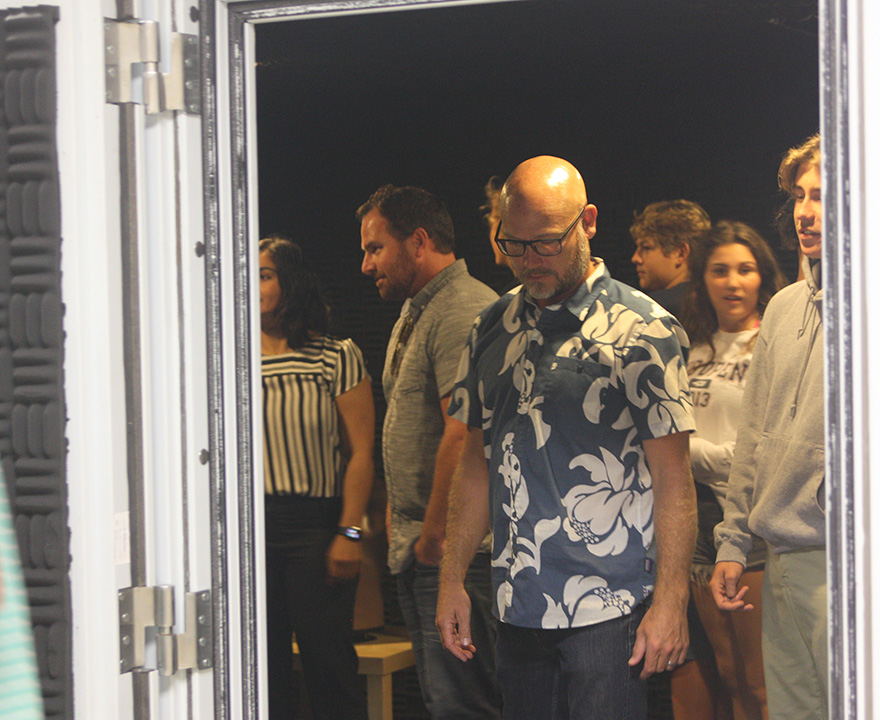Quieting the senses

Quieting the senses
- October 25, 2017
- Experiencing echo-free silence in UCI’s anechoic sound chamber helps students appreciate the noise of life
-----
 When Clinton Haycraft, head music teacher at The Discovery Prep School in Aliso Viejo,
wanted his students to feel how the human ear receives and translates acoustic information
to orient the brain, he knew the UCI Department of Cognitive Sciences was the perfect
place for such an experiment. Known for its focus on the brain, perception, cognition,
and behavior, the department boasts a premier anechoic sound chamber.
When Clinton Haycraft, head music teacher at The Discovery Prep School in Aliso Viejo,
wanted his students to feel how the human ear receives and translates acoustic information
to orient the brain, he knew the UCI Department of Cognitive Sciences was the perfect
place for such an experiment. Known for its focus on the brain, perception, cognition,
and behavior, the department boasts a premier anechoic sound chamber.
“I had taken my music classes to such facilities while teaching at the University at Buffalo, New York, and it always proved to be a very fun and informative experience,” says Haycraft who holds a Ph.D. in music composition. “Understanding how the human ears use acoustic information to orient the human brain in various environments is one aspect of our class discussions.”
The School of Social Sciences Anechoic Facility includes a large (12.5′x12.5′x7′ interior) acoustically isolated RF-shielded chamber that allows researchers to completely isolate sounds in an echo-free environment. Officially opened in fall 2011, the facility features state-of-the-art equipment including a harmonizer, function generators, oscilloscopes, mixers/equalizers, amplifiers, an auditory brainstem recording setup, MIDI microprocessors, and research-quality vocal microphones and headphones. It’s managed by UCI cognitive scientists Bruce Berg, Greg Hickok, Ginny Richards, and Kourosh Saberi who focus on hearing, speech, and language.
“One in six Americans will experience a communication disorder in his or her lifetime, and 3 out of 1000 newborns in the U.S. have a measurable hearing loss that can affect their speech, language, and cognitive development,” says Saberi. “Communication and hearing disorders affect not only physical wellbeing, but also social, emotional, recreational, and educational qualities of life. The effects are not limited to the individual, but often affect their families and friends.”
At UCI, faculty and students use the latest research techniques and cutting edge technologies to better understand how the human auditory system processes complex sounds such as speech and music.
“And with the opening of the Facility for Imaging and Brain Research, we’re collaboratively conducting research that will help us gain insight into how different regions of the brain are involved in processing sounds and how damage to these areas affects the perception of sounds,” he adds.
Below, Haycraft discusses the class trip to UCI, which also included a quick tour of FIBRE.
---
What lessons were you teaching the students leading up to the visit, and how did that connect with UCI's Anechoic and FIBRE facilities?
The course I am presently teaching is held at Los Rios Rock School for the students of The Discovery Prep School and integrates rock music performance, basic music theory, music history, and the science of sound. Since the course covers so many aspects of sound, I approached the visit to the anechoic chamber from many angles.
Understanding how the human ears use acoustic information to orient the human brain in various environments was one aspect of our discussions. We also learned about the aesthetics of the American composer, John Cage, famous for his piece, 4'33", which is 4 minutes and 33 seconds of silence. We practiced sitting in silence ourselves, and discussed how this practice effected each one of us. Thus our approach ranged from the physical to the metaphysical, the objective to the subjective. The experience of being inside the anechoic chamber brought these ideas together in a very tangible way. I only expected the students to experience the anechoic chamber. The FIBRE facilities were an unexpected and delightful addition to the tour.
How do you feel this visit helped your students?
I urge everyone to visit an anechoic chamber if they have the opportunity. It can be a very revealing experience. We humans tend to take sound for granted, and being deprived of it for a few minutes can help us understand just how important it is to our existence. As a music teacher, I feel it is my responsibility to instill the importance of sound and music to my students, and the tour allowed me to do just that. I will never forget the first time I sat in an anechoic chamber, and it is my hope that now my students have experienced something they will never forget.
-----
Would you like to get more involved with the social sciences? Email us at communications@socsci.uci.edu to connect.
Share on:


